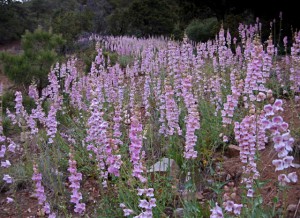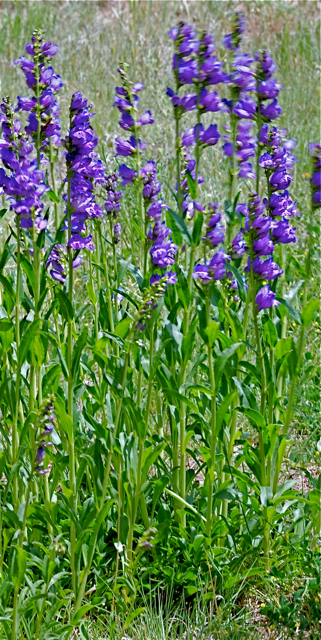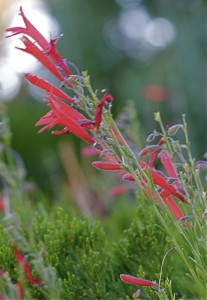The genus Penstemon
Including the pink balloon flower (Penstemon palmeri), Rocky Mountain penstemon (Penstemon strictus)
Plant family: Plantaginaceae
Article by Jeanne Gozigian
Penstemon are fascinating plants, so much so that there is an American Penstemon Society that is devoted to them. They are called beardtongues, because of the presence of the staminode, a long, infertile, and often hairy stamen. The genus Penstemon comes from Greek meaning ‘five stamens.’ They had been considered members of the Scrophulariaceae (Snapdragon) family, but more recent genetic research has moved them to the Plantaginaceae (Plantain) group. We all must be flexible with these name and classification changes.
Penstemon is a large genus, with 250 species. They are subshurbs and perennials that are native to Central and North America. Leaves are opposite in pairs and flowers have two lobes in the upper lip and three in the lower. Showy flowers on spikes occur in blues, reds, whites, and bicolors in hybrids. Many of the species are abundant in the wild, very cold hardy, and tolerant of dry conditions, from desert to mountain.

Stand of Penstemon palmeri (Photo by Pat Brown)
Some penstemon are very suited to border planting (e.g. P. strictus) , being tall and dominant. Others are dwarf and lend themselves to rock garden placement (e.g. P. pinifolius). All penstemon benefit from blossom cutback to encourage continued blooming and end of season cutback to ensure the next season’s growth. Penstemon palmeri, Pink Balloon Flower, is often used as a roadside planting where watering is not possible, as is Rocky Mountain Penstemon (Penstemon strictus). Hybrids need more frequent watering, although not as much when well established. They are best planted in well-drained fertile soil, in full sun.
There is mention in botanical literature of some medicinal use of penstemon by Native Americans, both for humans and animals; perhaps this was foxglove beardtongue (Penstemon digitalis). It was said to have helped treat chills and fever, while the roots were chewed to ease toothache. Such use is no longer encouraged. Hummingbirds love them, as their tubular shape lends itself to the birds’ feeding style. The Penstemon family’s early to mid summer flowering gives them a long blooming period, which can be extended with deadheading. Propagation can be from seed, cuttings, and transplanting. Give the plants plenty of room, as they will naturally spread with seed dropping.

Rocky Mountain Penstemon (P. strictus) stand by Janice Tucker
Santa Fe Botanical Garden’s Museum Hill site has the following wild and hybrid varieties of penstemon:
Bridges’ penstemon (P. rostriflorus)
Pike’s Peak Purple penstemon (P. barbatus × mexicali ‘Pike’s Peak Purple‘)
RED ROCKS™ penstemon (Penstemon × mexicali RED ROCKS™)
Compact pineleaf penstemon (P. pinifolius ‘Compactum’)
Rocky Mountain penstemon (P. strictus)
Recent 2014 additions (read about how our interns helped with the plantings):
Firleaf penstemon (P. abietinus)
Toadflax penstemon (P. linarioides)
Bluemat penstemon (P. linarioides var. coloradensis SILVERTON)
James beardtongue (P. jamesii)

Pineleaf penstemon (P. pinifolius) by Janice Tucker
The plan is to add more species as they are acquired. The garden was spectacular in late June with many Penstemon in bloom.
Wild varieties occurring at the Leonora Curtin Wetland Preserve and the Ortiz Mountain Educational Preserve are:
James Beardtongue (P. jamesii)
Rocky Mountain Penstemon (P. strictus)
Sidebells Penstemon (P. secundiflorus)



